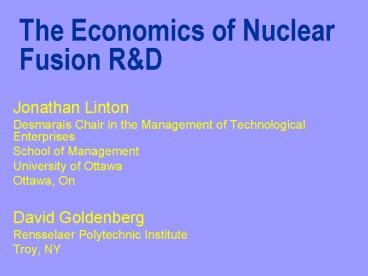The Economics of Nuclear Fusion R - PowerPoint PPT Presentation
Title:
The Economics of Nuclear Fusion R
Description:
Need to assume that costs and revenues are known in the future. ... Advantage and value of conducting research into more than one technology (Max-min option) ... – PowerPoint PPT presentation
Number of Views:41
Avg rating:3.0/5.0
Title: The Economics of Nuclear Fusion R
1
The Economics of Nuclear Fusion RD
- Jonathan Linton
- Desmarais Chair in the Management of
Technological Enterprises - School of Management
- University of Ottawa
- Ottawa, On
- David Goldenberg
- Rensselaer Polytechnic Institute
- Troy, NY
2
What Fusion is worth, depends on the future cost
of energy
If perpetual motion machines become available,
energy prices decline
... Nuclear fusion could becomes valueless
If reserves decline for traditional energy
sources and demand continues to grow, energy
prices increase
Nuclear fusion becomes very valuable
3
Application of Capital Budgeting
- Need to assume that costs and revenues are
known in the future. - It is not possible to accurately forecast demand,
supply or price of commodities far into the
future. - It is not possible to forecast the degree of
success of an RD program in the future or the
rate of improvement in technology in the future. - Attempts to do so are needed, but easily
challenged.
4
An Alternative Approach
Consider RD as insurance against the
possibility of high future energy prices
Invest in RD or an RD portfolio To purchase
protection against unattractive energy costs
and/or cost volatility
5
Simplest Case Black-Scholes
- N(.) is the standard cumulative normal
distribution. - St is the current stock price,
- r is the annualized risk-free rate,
- s is the annualized instantaneous volatility of
percentage rates of return on the stock, - tT-t is the time to expiration, and
- E is the exercise price.
6
Assumptions of the Black-Scholes Pricing Formula
- The model assumes that the underlying asset
follows a stationary log-normal diffusion process
described by the stochastic differential
equation - dStmStdt sStdZt
- where Zt is a standard arithmetic Brownian
Motion process.
7
The Black-Scholes Option Pricing Formula
The Black-Scholes formula gives the current
value of a European call option, C(St), as
C(St)StN(d1)-exp-rtEN(d2) where
d1ln(St/E) (rs2/2)t/ssqrt(t) and
d2d1-sqrt(t)
8
Assumptions (cont.)
- Under this description the log-normal
diffusion process is essentially Geometric
Brownian Motion. - Black, Scholes, and Merton won the Nobel prize
in economics for this model in 1997 under the
title for a new method to determine the value of
derivatives.
9
N(.)
- is the standard cumulative normal distribution
- no assumptions required
10
St
- is the current stock price
- not available for real assets
- Consequently, we calculate the real stock price
that makes the option attractive
11
r
- is the annualized risk-free rate
- we utilize the average annualized Treasury Bill
yield.
12
s
- is the annualized instantaneous volatility of
percentage rates of return on the stock - this is typically the most difficult part of
calculating any option price - historical volatility of same or similar assets
is used
13
tT-t
- is the time to expiration
- given RD spending in 2002 and
commercialization in 2050 - time to expiration is 48 years
14
E
- is the exercise price
- the exercise price is the cost of obtaining the
benefit - cost of building and decommissioning nuclear
fusion facilities to meet demands for first
fifty years of commercialization - note this involves all fixed costs
15
Assessment of Needed Benefits to Make RD
worthwhile
See DH Goldenberg and JD Linton, Energy Risk,
January 2006
16
Additional notes on Black-Scholes
- If the stock price, the expected savings, is
desirable then the RD should be conducted - Note the stock price does not take into account
fixed costs of introduction, these are addressed
in the exercise price - The stock price considers time-adjusted revenue
minus variable costs
17
Other Problems that can be considered using Real
Options
- Advantage and value of conducting research into
more than one technology (Max-min option) - Considering RD as a series of sequential options
(Compound option) - Value of postponing certain investments, but
maintaining option of conducting RD at a later
time (American option) - Value of developing/maintaining domestic
capabilities (Various)































